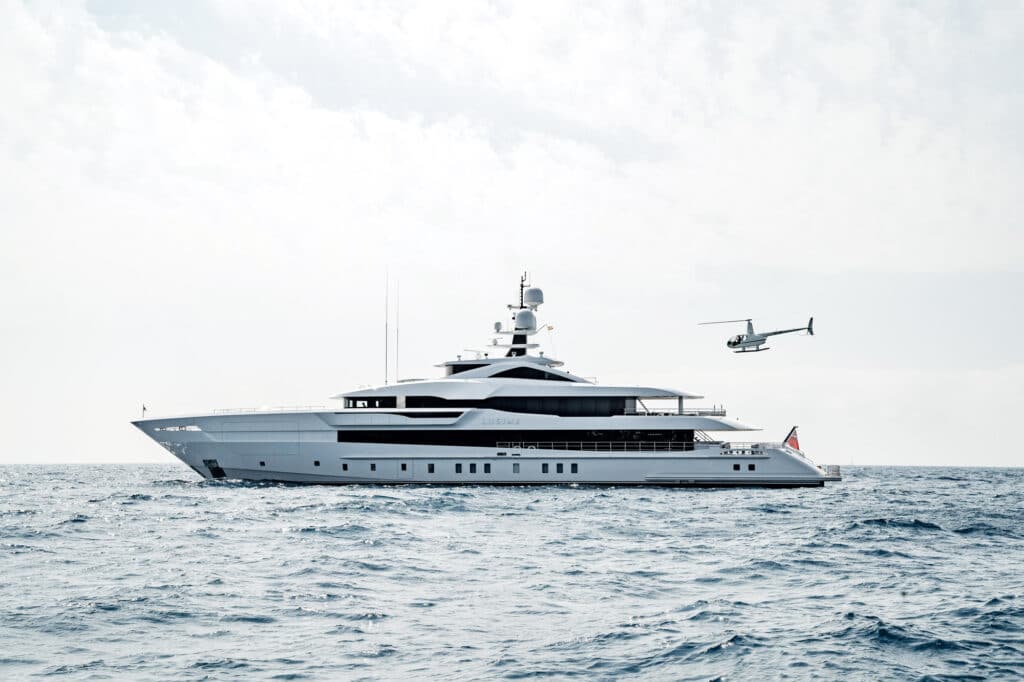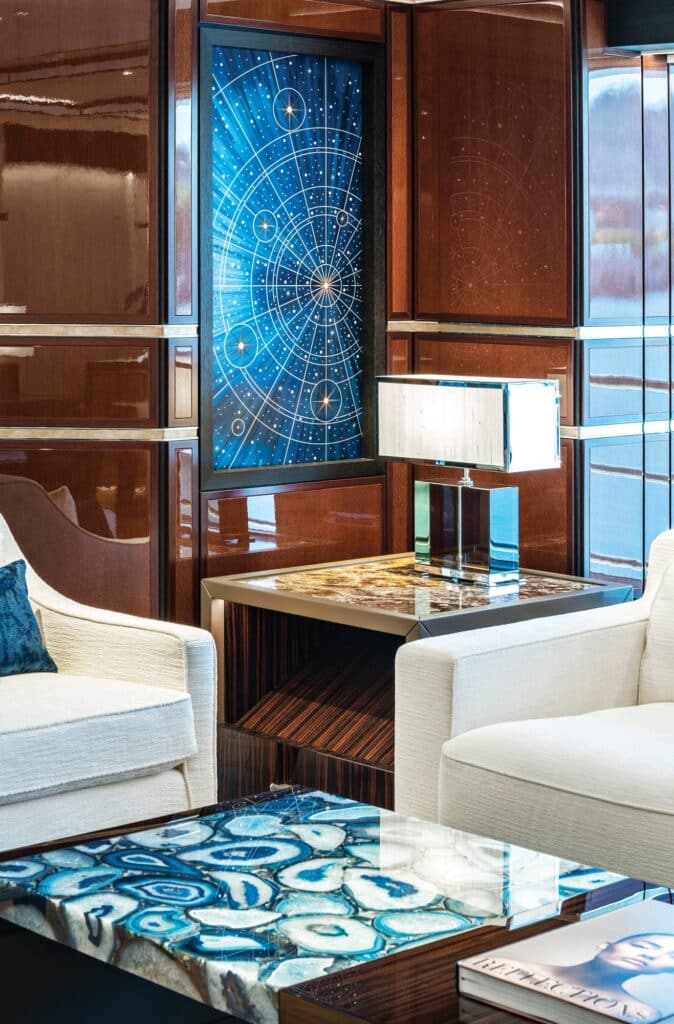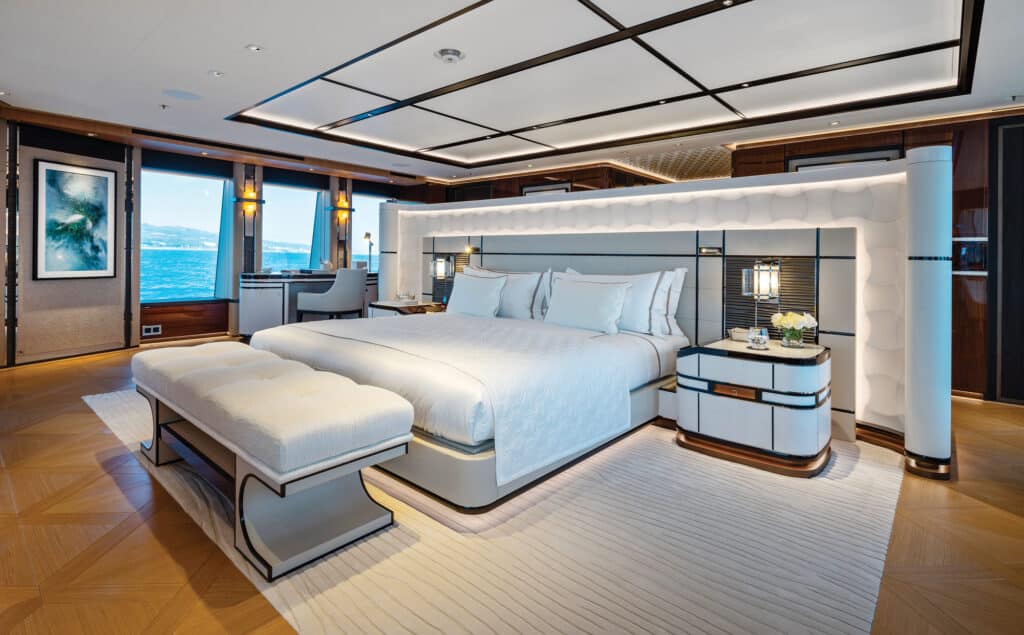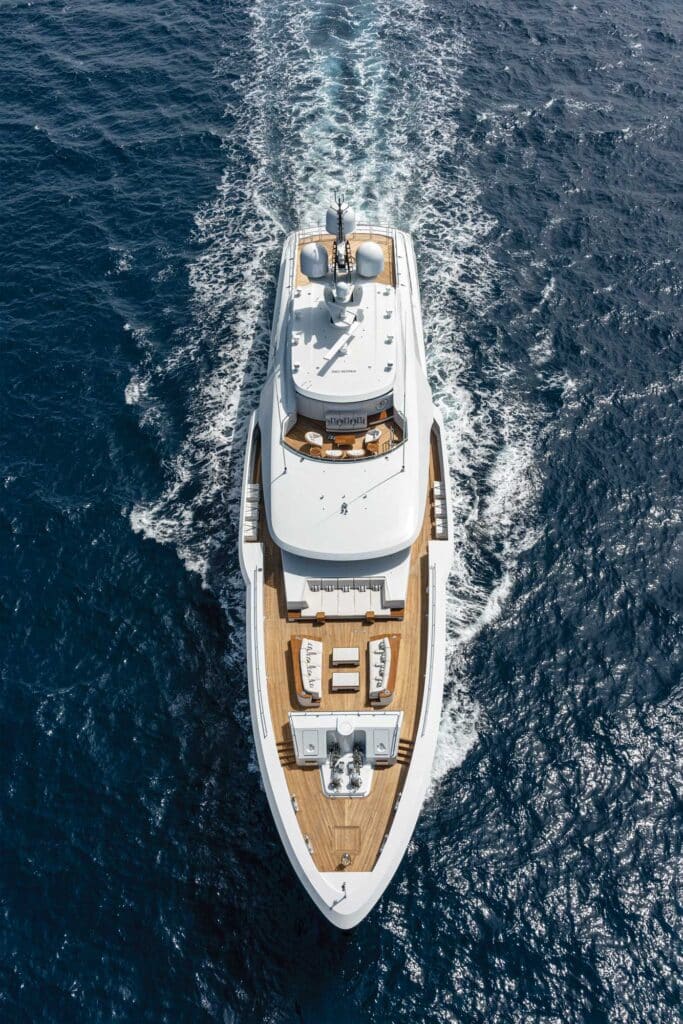
The Armenian word lusine translates to “moon” in English. That’s why, aboard the 198-foot Heesen Lusine, lunar and celestial themes are everywhere, from wall features to the teak decking. A crescent moon, for instance, is in the middle of the helipad. Even the font of the yacht’s name runs from thin to thick, reflecting the moon’s four waxing and waning phases.
Sinot Yacht Architecture & Design in the Netherlands created the opulent, almost art deco interior, which Heesen says is by far the most complicated and expensive it has ever produced. Initially, the yacht’s owner was inspired by Heesen’s then-Project Ceres (which launched as Galactica), but he ended up developing a fully custom vessel. At 1,079 gross tons, and based on a Fast Displacement Hull Form by Dutch naval architecture firm Van Oossanen, Lusine is Heesen’s longest and biggest-volume steel-hull yacht to date. The overall design process was led by Frank Laupman’s team at the Dutch firm Omega Architects.
Lusine’s profile fuses contemporary and modern styling to stunning effect. While the bow is conventionally pointed, the superstructure is more angular and extends a little farther forward than usual. The high foredeck terrace is vast and capable of hosting quite a party. The bridge-deck wing stations are exaggerated to create much wider side decks, and there is a hint of a bird’s wing amidships in the superstructure relief that cleverly integrates all the upper three decks without actually breaking the horizontal sweeps of glass along the main and upper decks.

Not only is the craftsmanship throughout Lusine exceptional, but the level of detailed design goes way beyond the norm as well. For instance, almost every piece of furniture is custom-size, and the breathtaking parquet soles, rich joinery and intricate marquetry are made from rare woods, special stones, and unusual leathers and skins, such as stingrays and puffer fish. One of the biggest design statements is the yacht’s circular staircase and glass elevator connecting all four decks, with a contoured leather mural depicting sea, land, air and then star themes as guests rise from the yacht’s lower deck to the top deck.
Lusine’s main-deck gathering spaces are conventional enough. Entering from the cockpit seating and dining space, the main-deck salon has lounge and dining areas aft, with an amidships galley and pantry to port. A companionway to starboard leads to the formal, double-glass-door entrance and to a side-boarding ladder beyond. The double-pedestal, cornice-topped dining table has radial Macassar veneers inlaid with gold leaf, blue agate and sycamore. The custom chandelier above is from Preciosa.
Accommodations are for 16 guests in eight en suite staterooms: three with double berths on the upper deck and five with twin berths on the lower deck. The lower-deck staterooms can also be used by personal staff.
The 540-square-foot owners’ stateroom is aft on the upper deck, where many other yachts have a sky lounge. Views from here are fabulous, with a 180-degree panorama to the sides and across the upper deck’s aft lounges, dining area and hot tub. The whole space can be secured for owner privacy.

Forward on the main deck is the L-shaped VIP stateroom, conceived for close family. It has an en suite double-berth stateroom and an adjacent en suite twin-berth stateroom. Both open onto a starboard-side private sitting room, which connects to the yacht’s main lobby.
The crew complement is 15. A captain’s cabin is to port abaft the modern, paperless bridge, with the remainder of the crew cabins forward on the lower deck.
Lusine has room for three Boston Whaler tenders: a 270 Vantage, a 210 Dauntless and a 180 Dauntless. The smallest and largest are housed with various toys in a forward garage, which has hinge-up doors to either side of the bow. The 210 is kept in the stern garage with more toys.
For air arrivals, a touch-and-go helipad is on the after end of the top deck. Interestingly, the area around the mast base and at the top of the central staircase is enclosed to create an alternative foyer for guests arriving this way. The space includes a pilot’s cabin.
Propulsion is twin 2,575 hp MTU 12V 4000 M65L diesels, which reportedly deliver a top speed around 18 knots and an ocean-straddling 4,200-nautical-mile range at 13 knots. Twin Naiad fins provide stabilization, and onboard power comes primarily from twin 315 kW Zenoro generators. The yacht’s air conditioning is built to high-tropical specification.

Lusine embodies all the knowledge and experience that Heesen has amassed by delivering more than 80 metal motoryachts with an average length of 155 feet in the past 20 years. The yard consistently delivers around four big yachts annually—not tied to the four phases of the moon but stellar nonetheless.
Touchstone
A coffee table in the main salon contains a small slice of lunar meteorite. A few of these rare rocks have been found on Earth and matched forensically with samples brought back from NASA’s Apollo missions. Scientists believe that the rocks arrived in debris showers following crater-creating events. A meteorite with proven provenance is the closest thing to a moon rock that money can buy; the real ones are owned by U.S. government agencies.
Now for Sale
Sadly, Lusine’s owner died right around the time the yacht was delivered. It’s now listed for sale “as new” with Burgess and is lying in the West Mediterranean. The asking price at press time was $82 million.
Ever Larger
Lusine is Heesen’s largest steel-hull motoryacht to date, but the yard’s largest project so far is the semi-displacement, all-aluminum, 263-foot, 1,700-gross-ton Galactica, which departed the Oss, Netherlands, yard in early 2022. Galactica is also reportedly the world’s largest and fastest motoryacht with a conventional shaft-line propulsion. Heesen says the vessel is capable of 29 knots, with four MTU 20V 4000 series engines.
Busy Builder
Heesen mostly builds semi-custom projects on common platforms. In recent years, most have been fast-displacement or semi-displacement hulls in steel/aluminum or all aluminum, but, occasionally, there’s a full-displacement steel/aluminum or all-aluminum project in the mix. Lusine is a good example of its steel-hull yachts.
Take the next step: heesenyachts.com









